Residual Stress Enhancement by Laser Shock Treatment in Chromium-Alloyed Steam Turbine Blades
Abstract
1. Introduction
2. Materials and Methods
2.1. Subsection
2.2. Loading Conditions
2.3. Materials and Constitutive Modelling
2.4. Analysis Steps
3. Results
4. Discussion
4.1. Effects of Laser Intensity
4.2. Effects of Superimposing Laser Shots
4.3. Effects of Shot Diameter
4.4. Effects of Peak Pressure Exposure Duration
4.5. Effects of Angle of Shot Impact
4.6. Analysis of Hierarchy of Influence of LSP Input Factors on Residual Stress Generation
5. Conclusions
Author Contributions
Funding
Institutional Review Board Statement
Informed Consent Statement
Data Availability Statement
Acknowledgments
Conflicts of Interest
References
- Crudo, C. Investigation on Laser Shock Peening Capability by FE Simulation. Ph.D. Thesis, University of Bologna, Bologna, Italy, 2013. [Google Scholar]
- Wu, G.; Aird, C.J.; Pavier, M.J. The effect of residual stress on a center-cracked plate under uniaxial loading. Int. J. Fract. 2019, 219, 101–121. [Google Scholar] [CrossRef]
- González-Arévalo, N.E.; Velázquez, J.C.; Díaz-Cruz, M.; Cervantes-Tobón, A.; Terán, G.; Hernández-Sanchez, E.; Capula-Colindres, S. Influence of aging steel on pipeline burst pressure prediction and its impact on failure probability estimation. Eng. Fail. Anal. 2020, 120, 104950. [Google Scholar] [CrossRef]
- Clauer, A.H.; Fairand, B.P.; Wilcox, B.A. Pulsed laser induced deformation in an Fe-3 Wt Pct Si alloy. Metall. Trans. A 1977, 8, 119–125. [Google Scholar] [CrossRef]
- Clauer, A.H.; Fairand, B.P. Interaction of Laser-Induced Stress Waves with Metals. In Applications of Lasers in Materials Processing; Metzbower, E.A., Ed.; American Society for Metals: Metals Park, OH, USA, 1979. [Google Scholar]
- Clauer, A.H.; Fairand, B.P.; Wilcox, B.A. Laser shock hardening of weld zones in aluminum alloys. Metall. Trans. A 1977, 8, 1871–1876. [Google Scholar] [CrossRef]
- Clauer, A.; Koucky, J. Laser Shock Processing Increases the Fatigue Life of Metal Parts. Mater. Process. Rep. 1991, 6, 3–5. [Google Scholar] [CrossRef]
- Zhao, J.; Dong, Y.; Ye, C. Laser shock peening induced residual stresses and the effect on crack propagation behavior. Int. J. Fatigue 2017, 100, 407–417. [Google Scholar] [CrossRef]
- Brockman, R.A.; Braisted, W.R.; Olson, S.E.; Tenaglia, R.D.; Clauer, A.H.; Langer, K.; Shepard, M.J. Prediction and characterization of residual stresses from laser shock peening. Int. J. Fatigue 2012, 36, 96–108. [Google Scholar] [CrossRef]
- Keller, S.; Chupakhin, S.; Staron, P.; Maawad, E.; Kashaev, N.; Klusemann, B. Experimental and numerical investigation of residual stresses in laser shock peened AA2198. J. Mater. Process. Technol. 2018, 255, 294–307. [Google Scholar] [CrossRef]
- Braisted, W.; Brockman, R. Finite element simulation of laser shock peening. Int. J. Fatigue 1999, 21, 719–724. [Google Scholar] [CrossRef]
- Wei, X.L.; Ling, X. Numerical modeling of residual stress induced by laser shock processing. Appl. Surf. Sci. 2014, 301, 557–563. [Google Scholar] [CrossRef]
- Achintha, M.; Nowell, D. Eigenstrain modelling of residual stresses generated by arrays of LSP shots. Procedia Eng. 2011, 10, 1327–1332. [Google Scholar] [CrossRef][Green Version]
- Wu, B.; Tao, S.; Lei, S. Numerical modeling of laser shock peening with femtosecond laser pulses and comparisons to experiments. Appl. Surf. Sci. 2010, 256, 4376–4382. [Google Scholar] [CrossRef]
- Karbalaian, H.; Yousefi-Koma, A.; Karimpour, M.; Mohtasebi, S. Investigation on the Effect of Overlapping Laser Pulses in Laser Shock Peening with Finite Element Method. Procedia Mater. Sci. 2015, 11, 454–458. [Google Scholar] [CrossRef]
- Bhamare, S.; Ramakrishnan, G.; Mannava, S.R.; Langer, K.; Vasudevan, V.K.; Qian, D. Simulation-based optimization of laser shock peening process for improved bending fatigue life of Ti–6Al–2Sn–4Zr–2Mo alloy. Surf. Coat. Technol. 2013, 232, 464–474. [Google Scholar] [CrossRef]
- Jiang, Y.F.; Ji, B.; Gan, X.D.; Hua, C.; Li, X.; Zhu, H. Study on the effect of laser peening with different power densities on fatigue life of fastener hole. J. Opt. Laser Technol. 2018, 106, 311–320. [Google Scholar] [CrossRef]
- Lin, B.; Zabeen, S.; Tong, J.; Preuss, M.; Withers, P. Residual stresses due to foreign object damage in laser-shock peened aerofoils: Simulation and measurement. Mech. Mater. 2015, 82, 78–90. [Google Scholar] [CrossRef]
- Purohit, R.; Verma, C.; Rana, R.; Dwivedi, R.; Dwivedi, S. Simulation of shot peening process. Mater. Today Proc. 2017, 4, 1244–1251. [Google Scholar] [CrossRef]
- Wang, C.; Wang, X.; Xu, Y.; Gao, Z. Numerical modeling of the confined laser shock peening of the OFHC copper. Int. J. Mech. Sci. 2016, 108–109, 104–114. [Google Scholar] [CrossRef]
- Joshi, K.S.; Rajyalakshmi, G.; Ranjith, G.; Kalainathan, S.; Prabhakaran, S. Optimization of Laser Shock Peening for Titanium. Mater. Today Proc. 2018, 5, 12174–12186. [Google Scholar] [CrossRef]
- Fameso, F.; Desai, D. Explicit analysis using time-dependent damping simulation of one-sided laser shock peening on martensitic steel turbine blades. Simulation 2020, 96, 927–938. [Google Scholar] [CrossRef]
- Fameso, F.; Desai, D.; Kok, S.; Newby, M.; Glaser, D. Coupled explicit-damping simulation of laser shock peening on x12Cr steam turbine blades. J. Phys. Conf. Ser. 2021, 1780, 012002. [Google Scholar] [CrossRef]
- Fameso, F.; Desai, D.; Kok, S.; Newby, M.; Glaser, D. Simulation of laser shock peening on X12Cr steel using an alternate computational mechanical threshold stress plasticity model. Int. J. Adv. Manuf. Technol. 2020, 111, 1–11. [Google Scholar] [CrossRef]
- Djordjevic, N.; Vignjevic, R.; Kiely, L.; Case, S.; De Vuyst, T.; Campbell, J.; Hughes, K. Modelling of shock waves in fcc and bcc metals using a combined continuum and dislocation kinetic approach. Int. J. Plast. 2018, 105, 211–224. [Google Scholar] [CrossRef]
- Dassault Systemes. ABAQUS 6.14—Abaqus 6.14 Analysis User’s Guide; Dassault Systemes: Vélizy-Villacoublay, France, 2014; pp. 17–27. [Google Scholar]
- Hfaiedh, N.; Peyre, P.; Song, H.; Popa, I.; Ji, V.; Vignal, V. Finite element analysis of laser shock peening of 2050-T8 aluminum alloy. Int. J. Fatigue 2015, 70, 480–489. [Google Scholar] [CrossRef]
- Fabbro, R.; Peyre, P.; Berthe, L.; Sollier, A.; Bartnicki, E. Physics and applications of laser shock processing of materials. Proc. SPIE-Int. Soc. Opt. Eng. 2000, 3888, 155–164. [Google Scholar] [CrossRef]
- Peyre, P.; Berthe, L.; Vignal, V.; Popa, I.; Baudin, T. Analysis of laser shock waves and resulting surface deformations in an Al-Cu-Li aluminum alloy. J. Phys. D Appl. Phys. 2012, 45, 335304. [Google Scholar] [CrossRef]
- Armfield, D. Optimised Implementation of Physics-Based Strain-Rate Dependent Material Models for the Improved Simulation of the Laser Shock Peening Process. Master’s Thesis, University of Pretoria, Pretoria, South Africa, 2018. [Google Scholar]
- Kuveya, K.R.; Polese, C.; Newby, M. Laser Peening versus Shot Peening Effects on Residual Stress and Surface Modification of X12CrNiMo12 Turbine Blade. In Proceedings of the 6th International Conference on Laser Peening and Related Phenomena, Johannesburg, South Africa, 6–11 November 2016. [Google Scholar]
- Kok, S.; Beaudoin, A.J.; Tortorelli, D.A. On the development of stage IV hardening using a model based on the mechanical threshold. Acta Mater. 2002, 50, 1653–1667. [Google Scholar] [CrossRef]
- Zhang, Y.; Ren, X.; Zhou, J.; Lu, J.; Zhou, L. Investigation of the stress intensity factor changing on the hole crack subject to laser shock processing. Mater. Des. 2009, 30, 2769–2773. [Google Scholar] [CrossRef]
- Montross, C.S.; Wei, T.; Ye, L.; Clark, G.; Mai, Y.-W. Laser shock processing and its effects on microstructure and properties of metal alloys: A review. Int. J. Fatigue 2006, 24, 1021–1036. [Google Scholar] [CrossRef]
- Rubio-González, C.; Felix-Martinez, C.; Gomez-Rosas, G.; Ocaña, J.L.; Morales, M.; Porro, J.A. Effect of laser shock processing on fatigue crack growth of duplex stainless steel. Mater. Sci. Eng. A 2011, 528, 914–919. [Google Scholar] [CrossRef]
- Ran, Z.; Yongkang, Z.; Guifang, S.; Xuting, S.; Pu, L. Finite Element Analysis of Surface Roughness Generated by Multiple Laser Shock Peening. Rare Met. Mater. Eng. 2018, 47, 33–38. [Google Scholar] [CrossRef]
- Li, K.; Hu, Y.; Yao, Z. Experimental study of micro dimple fabrication based on laser shock processing. Opt. Laser Technol. 2013, 48, 216–225. [Google Scholar] [CrossRef]
- Cao, Y.; Shin, Y.C.; Wu, B. Parametric Study on Single Shot and Overlapping Laser Shock Peening on Various Metals via Modeling and Experiments. J. Manuf. Sci. Eng. 2010, 132, 061010. [Google Scholar] [CrossRef]
- Gujba, A.K.; Medraj, M. Laser peening process and its impact on materials properties in comparison with shot peening and ultrasonic impact peening. Materials 2014, 7, 7925–7974. [Google Scholar] [CrossRef]
- Trdan, U.; Grum, J. Evaluation of corrosion resistance of AA6082-T651 aluminium alloy after laser shock peening by means of cyclic polarisation and ElS methods. Corros. Sci. 2012, 59, 324–333. [Google Scholar] [CrossRef]
- Sathyajith, S.; Kalainathan, S. Effect of laser shot peening on precipitation hardened aluminum alloy 6061-T6 using low energy laser. Opt. Lasers Eng. 2012, 50, 345–348. [Google Scholar] [CrossRef]
- Cellard, C.; Retraint, D.; Franc, M.; Rouhaud, E.; Saunier, D.L. Laser shock peening of Ti-17 titanium alloy: Influence of process parameters. Mater. Sci. Eng. A 2012, 532, 362–372. [Google Scholar] [CrossRef]
- Evans, D.A.; King, A.; Pirling, T.; Bruno, G.; Withers, P.J. The effect of incidence angle on residual stress state in laser peened ti-6ai-4v plate. In Proceedings of the International Conference on Shot Peening, Paris, France, 9 September 2005; pp. 454–459. [Google Scholar]
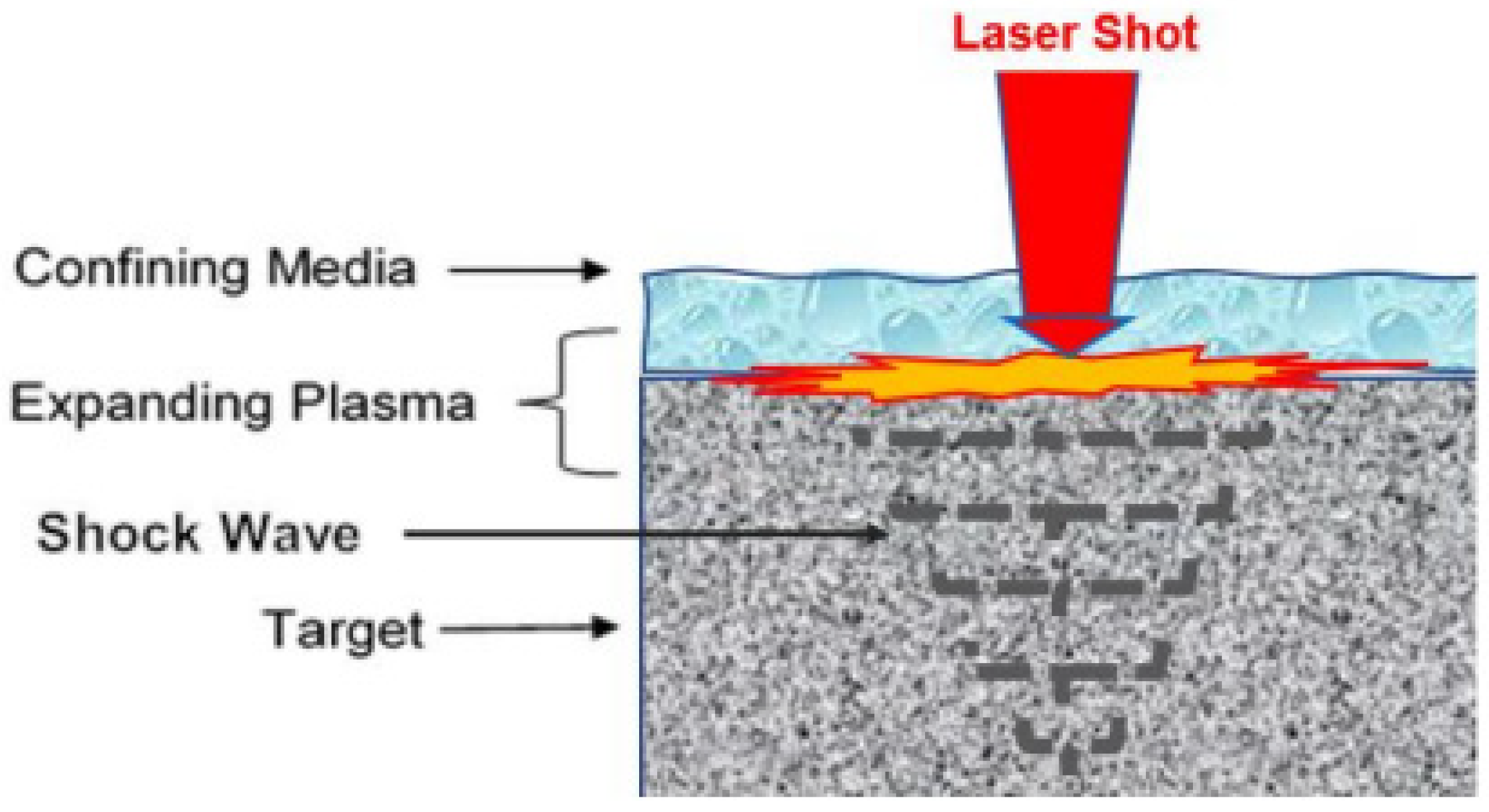


 ) indicating the onset of necking [30].
) indicating the onset of necking [30].
 ) indicating the onset of necking [30].
) indicating the onset of necking [30].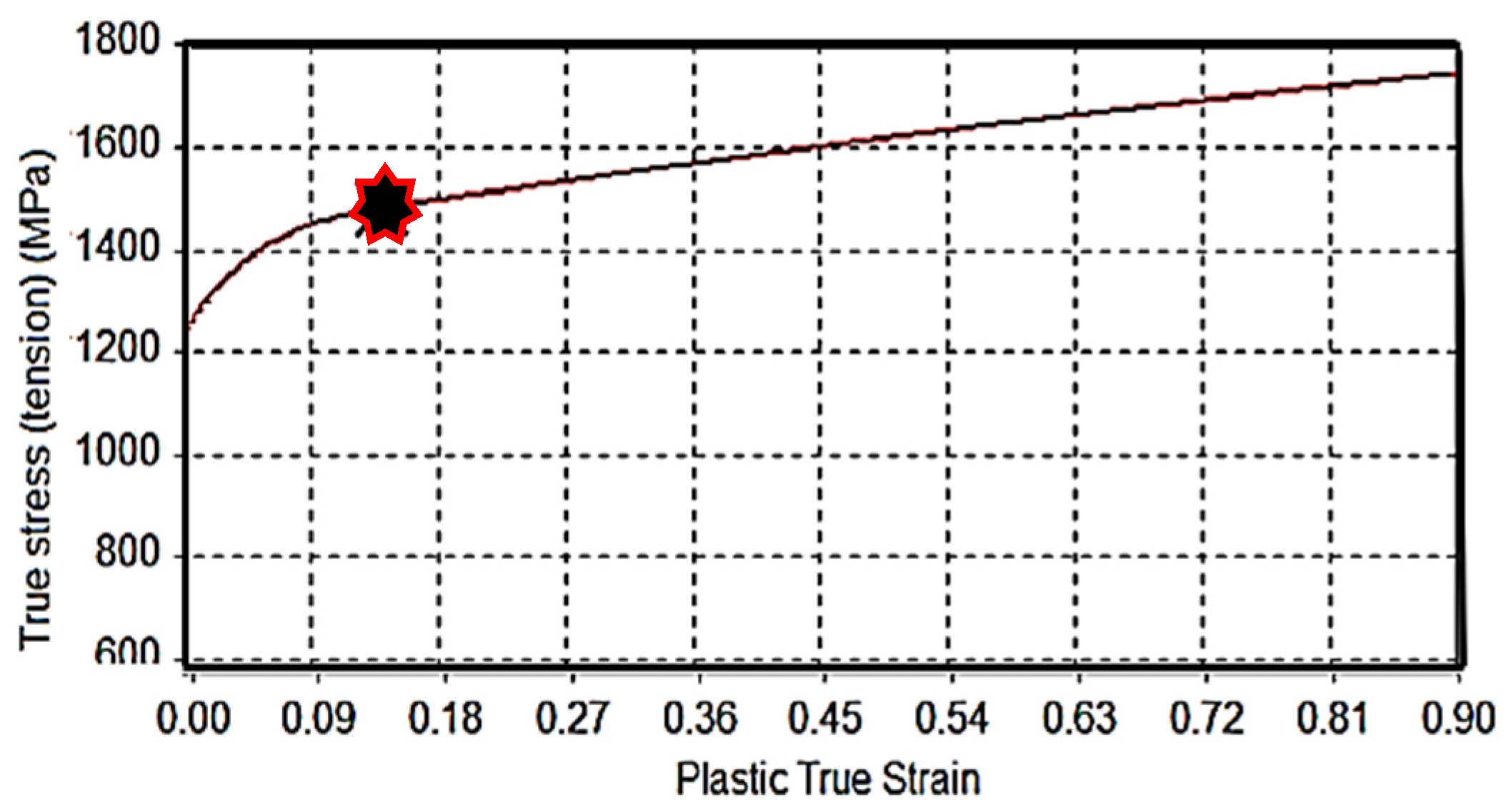
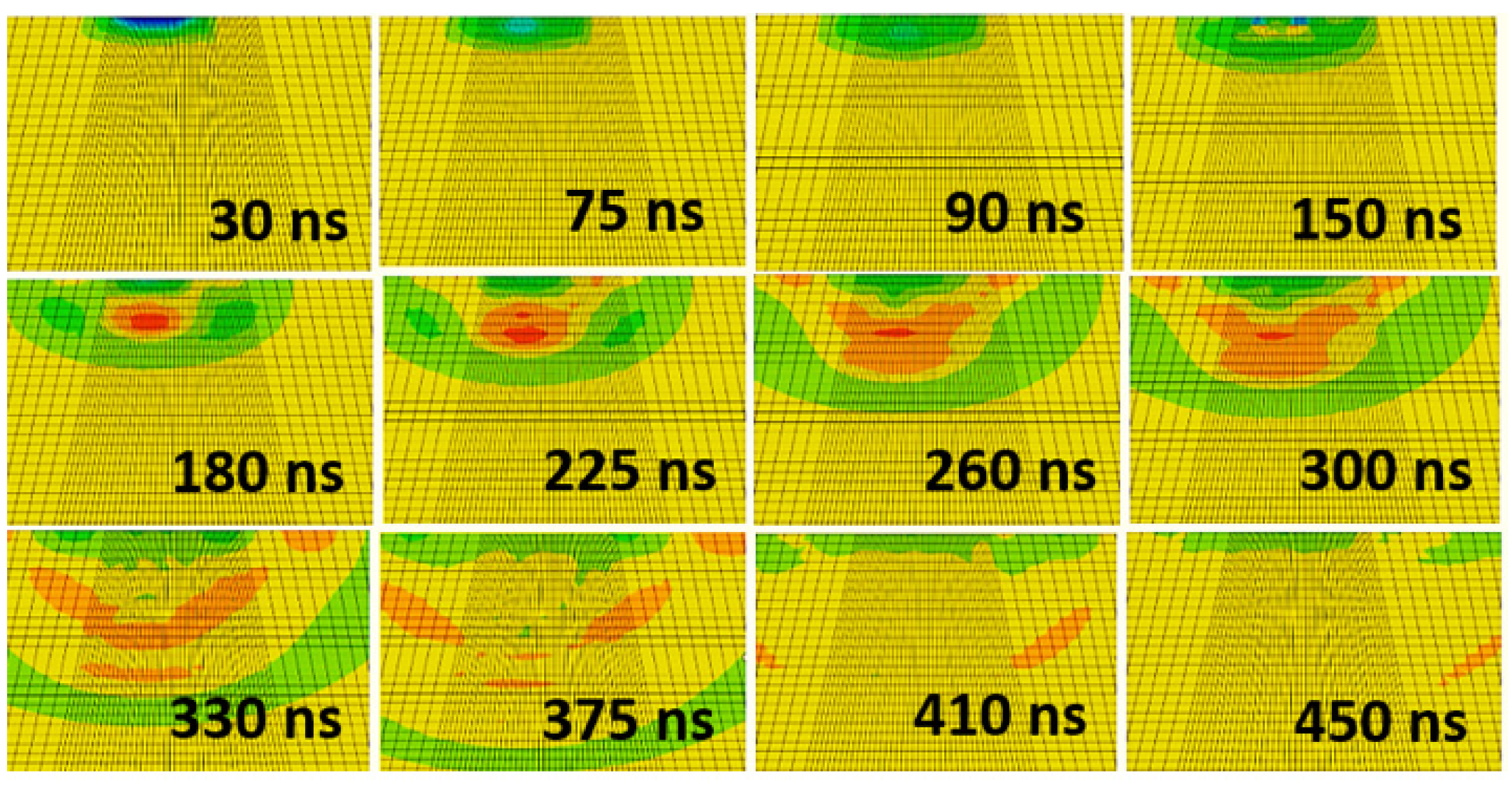



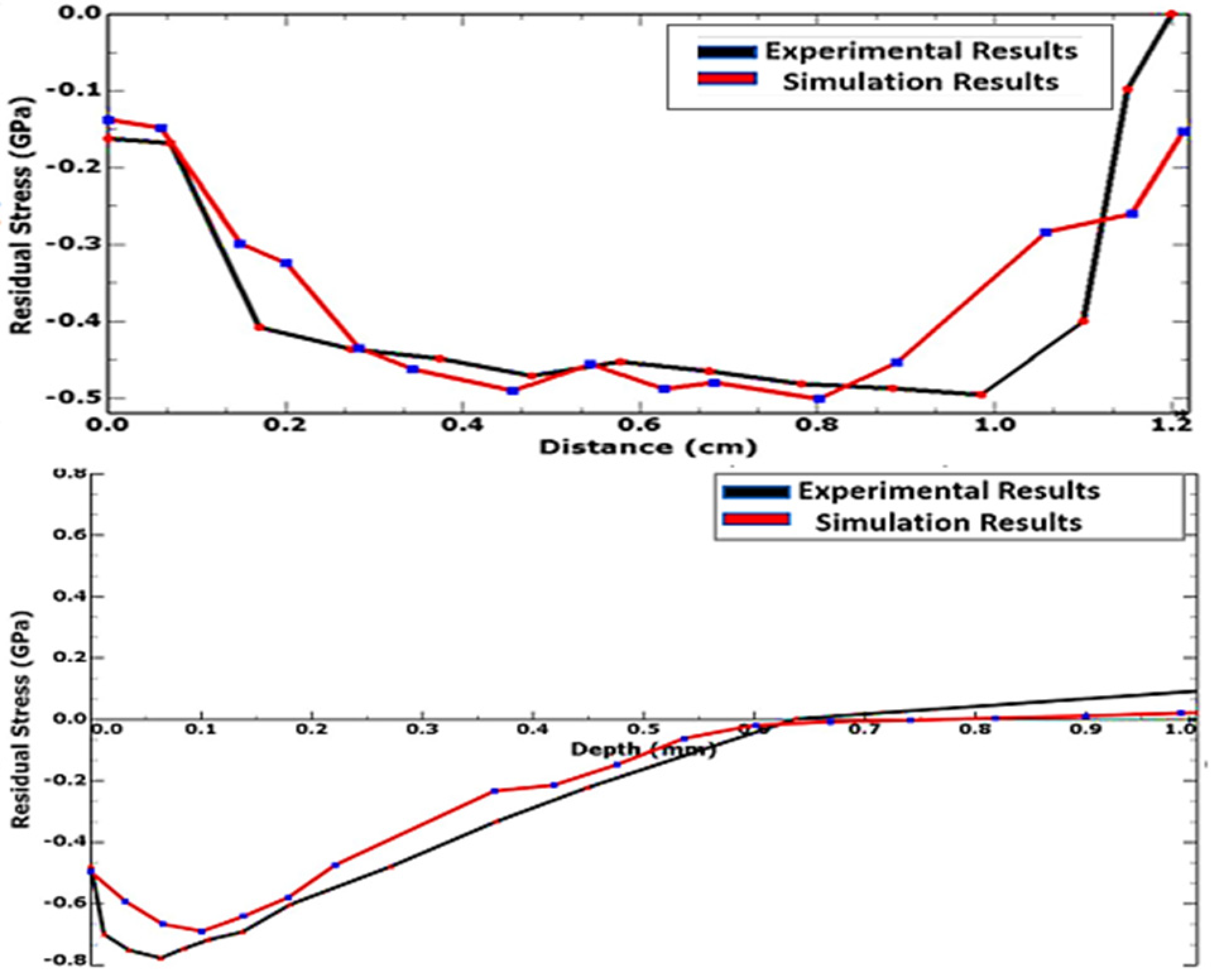
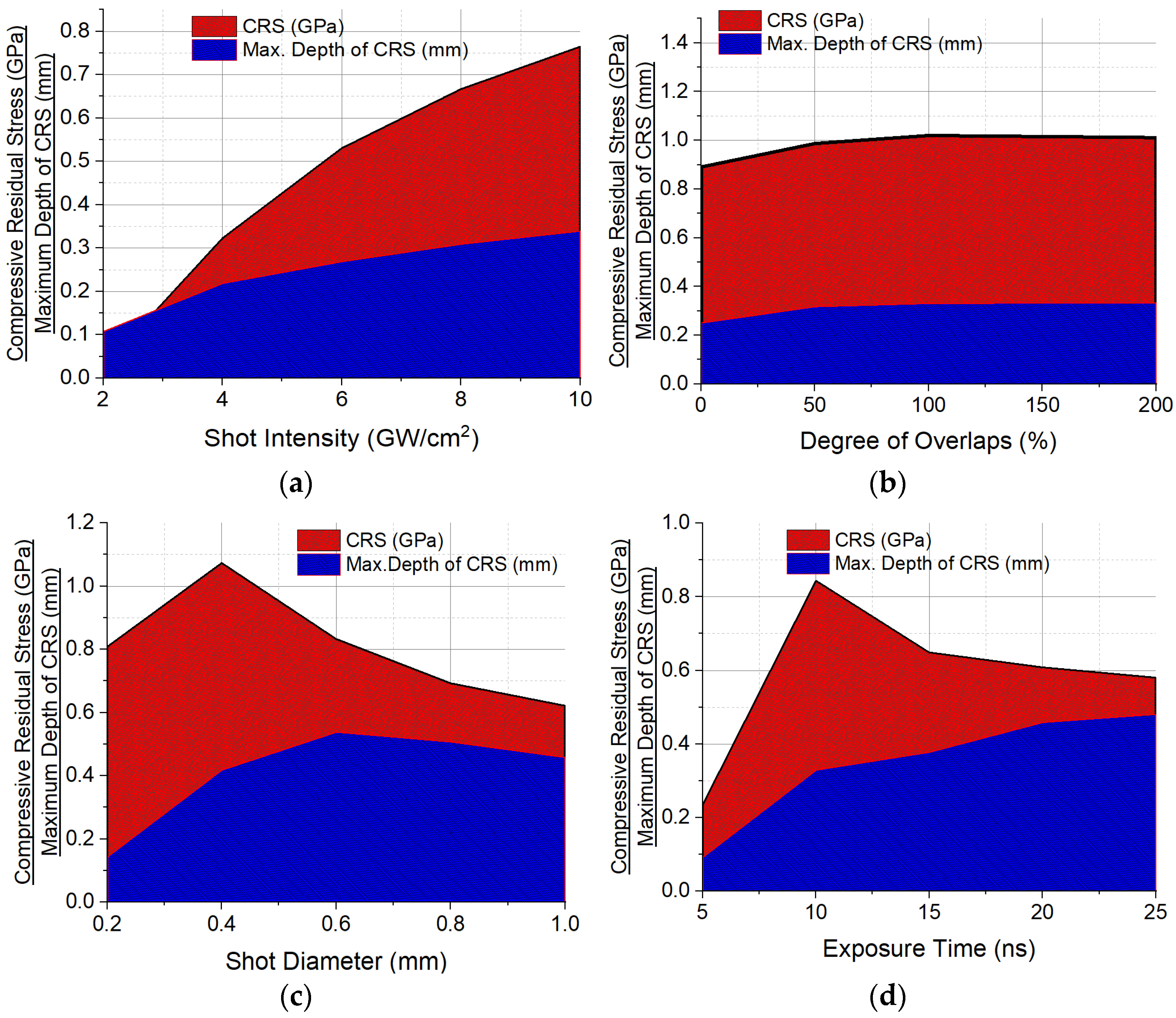
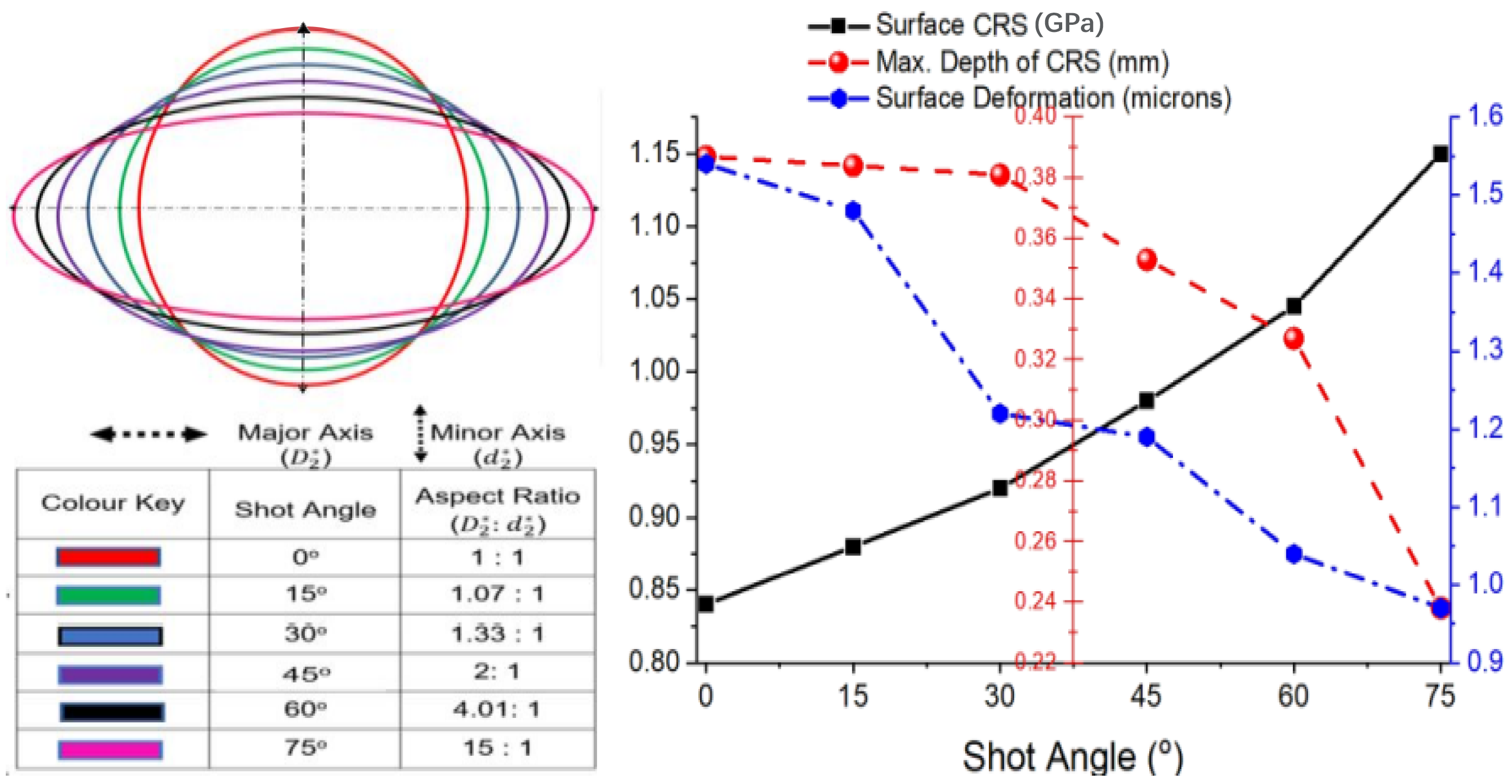
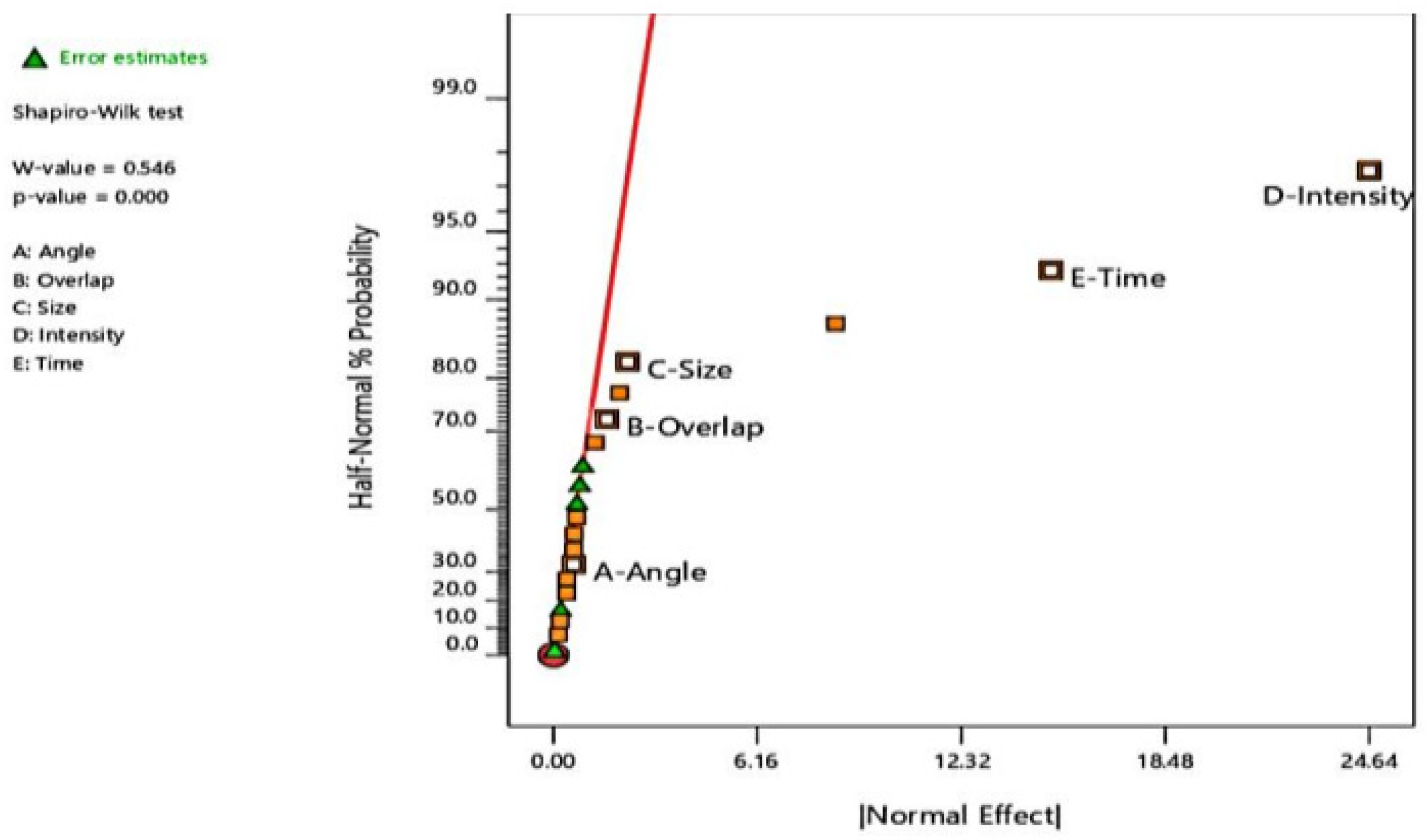
| Parameter | Value |
|---|---|
| Laser Power Intensity | 6 GW/cm2 |
| Peak Pressure | 4 GPa (approx.) |
| Coverage | 20 spots/mm2 |
| Spot Size | 0.6 mm |
| % Overlap | 83.3% |
| Step Time | 100 ns |
| Stress Damping Step Time | 500 ns |
| Number of runs | 1 × 2 |
| Property | Value |
|---|---|
| Density (kg/m3) | 7700 |
| Tensile Strength (MPa) | 950 |
| Yield Strength (MPa) | 800 |
| Elastic Modulus (GPa) | 204.2 |
| Poisson’s Ratio | 0.30 |
| Specific Heat (J/kg/k) | 490 |
| Thermal Conductivity (W/m2) | 2.06 |
| Shear Modulus (GPa) | 77 |
| Strain Hardening Modulus (MPa) | 300 |
| Damping Factor | 0.05 |
| Element | C | Si | Mn | Ni | P | S | Cr | Mo | V |
|---|---|---|---|---|---|---|---|---|---|
| Percentage Composition | 0.08–0.15 | Max 0.35 | 0.50–0.90 | 2.00–3.00 | Max 0.025 | Max 0.020 | 11.0–12.5 | 1.50–2.00 | 0.25–0.40 |
| Co (m/s) | S | Γ |
|---|---|---|
| 4313.65 | 1.4545 | 2.06 |
| Parameter | Simulation | Experiment | Variation |
|---|---|---|---|
| Surface CRS (GPa) | −0.48 | −0.46 | 3.6% |
| Maximum CRS Residual (GPa) | −0.715 | −0.77 | 7.1% |
| Maximum depth of CRS (mm) | 0.67 | 0.64 | 4.5% |
| Input Parameter | % Probability Coefficient | Decreasing Hierarchy of Influence | ||
|---|---|---|---|---|
| A | Shot Angle | 0.5 | Shock Intensity | 0.96 |
| B | Overlaps | 0.71 | Exposure Time | 0.92 |
| C | Shot Size | 0.82 | Shot Size | 0.82 |
| D | Shock Intensity | 0.96 | Overlaps | 0.71 |
| E | Exposure Time | 0.92 | Shot Angle | 0.5 |
Publisher’s Note: MDPI stays neutral with regard to jurisdictional claims in published maps and institutional affiliations. |
© 2022 by the authors. Licensee MDPI, Basel, Switzerland. This article is an open access article distributed under the terms and conditions of the Creative Commons Attribution (CC BY) license (https://creativecommons.org/licenses/by/4.0/).
Share and Cite
Fameso, F.; Desai, D.; Kok, S.; Armfield, D.; Newby, M. Residual Stress Enhancement by Laser Shock Treatment in Chromium-Alloyed Steam Turbine Blades. Materials 2022, 15, 5682. https://doi.org/10.3390/ma15165682
Fameso F, Desai D, Kok S, Armfield D, Newby M. Residual Stress Enhancement by Laser Shock Treatment in Chromium-Alloyed Steam Turbine Blades. Materials. 2022; 15(16):5682. https://doi.org/10.3390/ma15165682
Chicago/Turabian StyleFameso, Festus, Dawood Desai, Schalk Kok, Dylan Armfield, and Mark Newby. 2022. "Residual Stress Enhancement by Laser Shock Treatment in Chromium-Alloyed Steam Turbine Blades" Materials 15, no. 16: 5682. https://doi.org/10.3390/ma15165682
APA StyleFameso, F., Desai, D., Kok, S., Armfield, D., & Newby, M. (2022). Residual Stress Enhancement by Laser Shock Treatment in Chromium-Alloyed Steam Turbine Blades. Materials, 15(16), 5682. https://doi.org/10.3390/ma15165682







